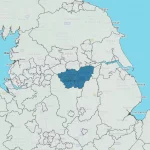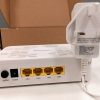New Technology Helps Subsea Fibre Optic Cables to Detect Sabotage

A new report reveals how several companies are responding to the growing problem of deliberate sabotage against vital subsea fibre optic cables, which carry much of the world’s internet data traffic, by turning those same cables into a sophisticated sensor net capable of detecting when, where and how an attack may be occurring.
The idea of using optical fibre cables, which transmit data using pulses of laser light, to detect and monitor nearby events is nothing new. For example, scientists have already found ways of turning such cables into Earthquake and Tsunami monitors (here and here), which works by detecting changes in the polarization of light as it moves through the cable (i.e. its electric field oscillates in just one direction, rather than any which way).
The above methods can usually be further refined by harnessing signal repeaters (these help to maintain the laser light), which are often installed up to every 90km or so on such cables (variable). But detecting anything more than big events in the deep ocean environment is much harder because the temperature remains fairly stable and there are few disturbances (i.e. the polarization is fairly stable).
Advertisement
However, the BBC News are today highlighting developments from a number of companies, such as Optics11, Viavi Solutions and also the notable AP Sensing, which has developed a system that can pick up the presence of vessels on the surface above, as well as anchor drops, divers or marine life touching the cables and the location of damage exactly when it occurs.
“With this technology, it is even possible to work out the approximate size of a vessel passing above a subsea cable, as well as its location and, in some circumstances, its direction of travel. That could be correlated with satellite imagery, or even automatic identification system (AIS) records, which most ships broadcast at all times,” said the report.
Admittedly, there are caveats to this, since the technology is normally unable to detect disturbances from very far away, although this can be mitigated by installing signal listening devices (interrogators) every 100km (62 miles) or so along a cable. Companies deploying this on new cables could of course combine that with the location of their repeaters.
The current technology can apparently pick up vibrations hundreds of metres away, but “usually not several kilometres away“, which makes sense given that the marine environment will have a lot of background noise to tackle (nature and other events). In addition, companies could consider using old retired cables, or even deploying cables specifically to act as a sensor net, which would make all of this much more accurate and extend the use into general monitoring of marine traffic.
Advertisement
All of this is currently forming part of the background to a new UK inquiry, which is being conducted by the Joint Committee on the National Security Strategy (JCNSS) and will see cross-party MPs and Lords examine the growing threats to undersea fibre optic cables (here). The inquiry, titled Undersea Cables, notes how over 500 cables carry around 95% of all international data and around 60 of those connect the UK to the outside world.
However, the problem isn’t all about sabotage, with submarine cables frequently also suffering from accidental damage too (e.g. the nets used by deep sea fishing trawlers, as well as ships accidentally dragging their anchor over them, abrasion, equipment failure etc.). According to the International Cable Protection Committee (ICPC), an average of 150 to 200 faults occur globally each year – requiring about three cable repairs per week (here). Often it can take several weeks to fix a break, but this depends upon the type of break, its depth, weather conditions and various other factors.
Suffice to say that any technology that can help make tackling this sort of problem or threat easier, and perhaps even prevent such incidents from occurring, is likely to be very helpful.
Mark is a professional technology writer, IT consultant and computer engineer from Dorset (England), he also founded ISPreview in 1999 and enjoys analysing the latest telecoms and broadband developments. Find me on X (Twitter), Mastodon, Facebook, BlueSky, Threads.net and Linkedin.
« O2 UK’s AI Flags 50 Million Suspected SPAM and Scam Calls a Month
Guernsey Court Overturns £3m of Telecoms Competition Fines »






















































Is this article referring to the use of DFOS (Distributed Fibre Optic Sensing)?
DFSO is a general classification for a set of technologies that are used to detect environment changes using fibre cable runs, but the original article that this article is referring to may also be referencing a couple of new techniques in addition to temperature and sound based techniques not commonly used before now.
There are currently no confirmed cases of “deliberate sabotage” to subsea cables. The use of fibre sensing with AIS, and through in a bit of AI, and it will be a very useful tool in identifying vessels that damage cables, whether the process will be quick enough to “prevent” a damage occurring is another thing.